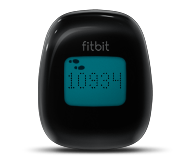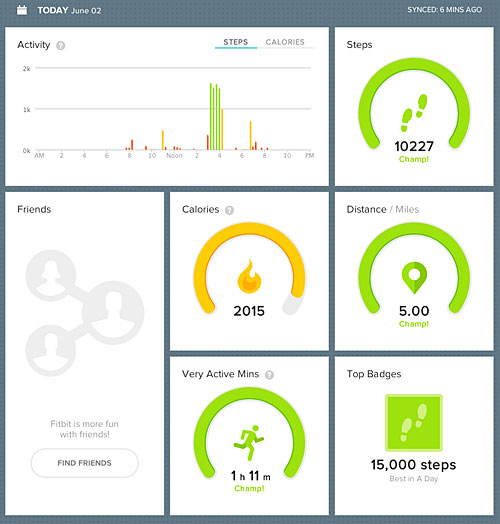Your grandfather probably doesn’t have a pedometer, but if he does, I’ll bet it’s not a Fitbit.  Debbie and I both acquired a Fitbit Zip via our participation in a wellness program sponsored by BP, in which the company is challenging employees and retirees (we, of course, fall into the latter group) to rack up a million steps over the course of a hundred days. That works out to 10,000 steps a day, and it’s been interesting to see how wearing the tiny device acts as a motivator to try to achieve that goal.
Debbie and I both acquired a Fitbit Zip via our participation in a wellness program sponsored by BP, in which the company is challenging employees and retirees (we, of course, fall into the latter group) to rack up a million steps over the course of a hundred days. That works out to 10,000 steps a day, and it’s been interesting to see how wearing the tiny device acts as a motivator to try to achieve that goal.
I was initially skeptical. We’re regular exercisers, and a normal workout is either a five mile run, 45 minutes on a stationary bike, or a twenty mile tandem bike ride, and I would categorize our lifestyle as “active,” especially when you add in the dancing. So I figured it would be a breeze to get 10,000 steps in a day, but I also thought that I’d quickly decide that a pedometer was a lame idea and set it aside after a short time.
But the Fitbit unit itself is just a piece of the entire system, and it’s the system that makes the program attractive. The unit automatically tracks your daily steps, mileage, and calories burned (based on your height, weight, and age), and resets itself to zero each 24 hours (but still counts the calories that a normal resting metabolism consumes even during sleep, which is a nice touch).
It then periodically syncs with your smartphone, tablet, and/or computer, and provides a “dashboard” that provides a nice visual status report of how you’re doing. Here’s a screenshot of my dashboard from a couple of weeks ago.

Notice how I cleverly picked a day where I did good?
In the live Dashboard (which, by the way, is very nice piece of programming…very responsive), you can mouse over the bar graph to see the actual number of steps recorded for a given time period, and I find it interesting to see how activity level varies throughout the day. June 2nd was a Sunday, and other than walking around church and going to the grocery store, we didn’t do much until about 3:00 p.m., when we went for a four-mile walk through the neighborhood. A normal day at the office yields 2,500-3,500 steps for me, depending on how many trips between floors I have to make via the stairs.
Even if you’re not a walker or a runner, you can get credit for your activities by manually entering them via the website. The site also provides a section for tracking your diet, although I haven’t done anything with it. And if you’re the competitive type, you can hookup via Facebook with other Fitbitizens to do the social thing. Again, not my bag, but it may be a motivator for some.
I didn’t expect that putting a Fitbit on my belt or waistband would change the way I perceive normal everyday activities, but it has. There’s something satisfying about knowing that mowing the yard, or walking to the mailbox, or vacuuming the house is not only accomplishing a task that needs to be done, it’s also contributing to the achievement of a goal.
It can get a little silly, though. Last night, just before bedtime, I was getting ready to retire the Zip for the night and I saw that it read 15,905 steps. I’m just OCD enough to not be able to let that go, and so I made a few laps around the living room and kitchen in order to break the 16K mark. So I’ve got that going for me.
There are more expensive Fitbit models; one purports to track your sleep habits, although the reviews are mixed regarding its effectiveness. Another model is in the form of a wristband, but it lacks the display of the Zip.
Having lived with the unit for a month, I would gladly pay the purchase price to have one. The basic model is $60. But BP thinks highly enough of the potential to improve health that it provided the units to employees and retirees for free.
